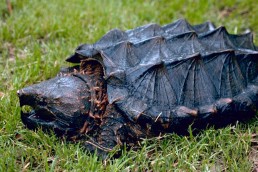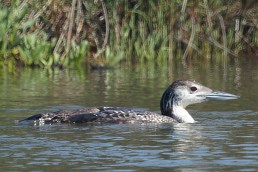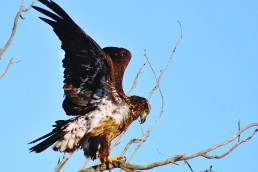Midwest Wildlife Wisdom
SHARE THIS POST
Alligator snapping turtle
America’s largest freshwater turtle is the alligator snapping turtle. But many don’t know the extent of their range. Alligator snapping turtles’ strongholds are in rivers and swamps of the South But this doesn’t mean there aren’t any in the Midwest. Alligator snappers can be found in Illinois, with some questionable records occurring even farther north. Their massive size and unique hunting style make the snappers so interesting. Instead of actively searching for food, alligator snappers ambush their prey. But they will not pass up free meals of carrion, like on catfish trotlines. This turtle ambushes fish by opening its huge mouth, which has a small, red tongue inside and looks similar to a red, wiggling worm. When fish are present, it wiggles its tongue in hopes of luring in a fish. If one falls for the trick they’re then crushed by the turtle’s beak-like mouth.
Whirligig beetle
Go to any stagnant or slow-moving body of water in the summer and you’re bound to see the surface abuzz with aquatic insects. Mostly, you’re going to see groups of insects known by the common name, “whirligig beetle.” Over 700 species of beetles occur in this family, but the majority look similar, making identification difficult. Simple in appearance though complex in nature, these small beetles have interesting behavioral patterns. Within those large congregations you see, the position of where a beetle is within a mass is based on a few factors. When a particular beetle is hungry, it positions itself on the outer reaches of the group where food is more prevalent, but also where predators are. Found primarily on the surface, these insects are well adapted for going underwater and can remain there for extended periods of time. Whirligigs have split eyes, meaning a set that can see under the water and above it when at the surface. This insect can form a small oxygen bubble that it carries underwater, allowing it to remain under for a long time.
Crayfish, crawfish, crawdads
Whether you call them crayfish, crawfish or crawdads, chances are you’re familiar with these common crustaceans. Unfortunately, many crayfish seen today are not supposed to be there, and these are the aggressive species known as the rusty crayfish. Originally from the Ohio River drainage, rusty crayfish have become the dominant species found throughout much of the Midwest. Rusty crayfish were believed to have been introduced accidentally by fishermen who used them as baits. They have prominent coloration features, with reddish spots on their sides, which gives them the name rusty crawfish. Second, they have a black band on the tip of their claws, which sometimes has an orange band. Other than replacing native crayfish species, the rusty has reduced biodiversity among other aquatic invertebrates, and worse, has removed aquatic vegetation used by everything from fish to plankton. We have another example here of a small animal or organism having a big impact.
Deer ticks
Knowing the dangers of the woods should be a top priority. But one of the most common and serious health hazards may get to you without you ever even knowing it: deer ticks and Lyme’s disease. Many are aware, but knowing exactly what the symptoms are and what a deer tick looks like should be common knowledge.
Are you enjoying this post?
You can be among the first to get the latest info on where to go, what to use and how to use it!
First, a deer tick looks like a shrunken wood tick with a red back that has a big, black oval in the middle. Compared to a “normal” wood tick, the differences are noticeable. When one is found stuck to you, it’s imperative to remove the tick right away. The longer it’s attached, the more likely you are to contract the disease. Lyme’s disease does not take long for symptoms to show up, usually starting with a red ring around the bite. Signs of illness quickly follow with symptoms similar to the flu, meaning aches, chills and a fever. If left untreated for months, the symptoms get serious and can affect the nervous system. This stage is accompanied by rashes, poor memory, acute pain in the limbs, rapid heartbeat and facial-muscle paralysis. Finally, the most serious stage occurring long after an initial bite comes with arthritis, confusion, irregular heartbeat and heart inflammation. Treatment should be administered as soon as any of the initial symptoms are noticed. If you find a tick stuck, don’t be hesitant to get tested for Lyme’s disease, as it is a serious illness that shouldn’t be taken lightly.
Fox sparrow
Darwin’s finches were known for their unique adaptations and filling their own niches. Our native birds sometimes have amazing habits not known by many. Look to the ground for the interesting food habits of the fox sparrow, an inconspicuous bird with less pronounced colors. A typical fox sparrow will have a gray and rust brown head, wings and back. Its belly is tan with flecks of gray and rust brown. These are a larger, round bird with a stout beak and an average-sized tail. Although not the brightest bird, the pattern fits them perfectly for their feeding behavior. Fox sparrows and other sparrow species get food by kicking up leaf litter using both talons and then eating the insects and seeds flying up in the air. Spending so much time on the ground does leave these birds vulnerable to predation, especially by the invasive house cat.
Berries
Letting nature provide you with food should not be exclusive to hunting and fishing. Mushrooming is a common practice, but there’s a form of harvesting that’s often forgotten about: berry picking. Berries in the right habitat can be a delicious, plentiful snack. Blackberries are common in the grocery store and can be seen when afield. These are characterized by their large size and black-purple color. The leaves from the blackberry tree are small and completely serrated. A plant that produces berries will see birds come that eat the berries and then spread the seeds via their feces. Some of the plants have stems covered in thorns to prevent many animals from eating the berries. Your best bet for finding them is in open woodland areas that receive a lot of sun. Blackberries can completely cover nearby vegetation and structures, sometimes causing people to view them as a weed. Finding berries is an easy, rewarding and fun way to get outside.
MWO
SHARE THIS POST
Did you enjoy this post?
You can be among the first to get the latest info on where to go, what to use and how to use it!
Calvin Vick
MidWest Outdoors’ “Nature Notes” columnist Calvin Vick is an undergraduate studying biology, with an emphasis on herpetology, at the University of Central Arkansas. His primary interests are venomous snakes and salamanders. He spends most of his free time photographing the two.



